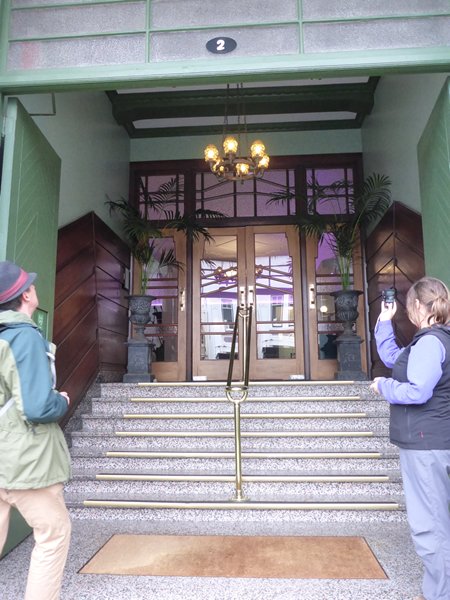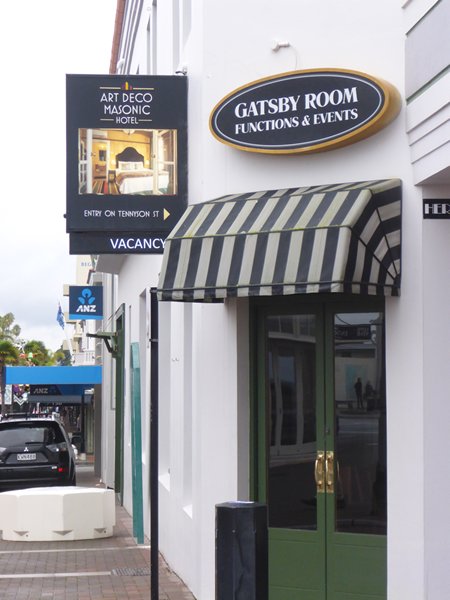NZ Napier

|
Are You Superstitious? Friday 13th April South to Napier Ever since Zoonie’s near sinking thirteen months and one day ago Rob and I have held the hope that somehow before we leave these fair shores we would be able to come and visit Napier and its surrounds as we had originally planned to do. But back then we had to drive non-stop back to Whangarei instead of turning right to Hawke’s Bay. Completed and opened in 1966 State Highway 2 stretched south from Gisborne over the flat plains of Gisborne County. Grapes, fruit especially kiwis and frijoas and lettuce covered the fertile soils. Fields of muscular Angus Bulls and goat farms heralded a change in livestock farming. The big dairy cattle farms are now changing their future plans. Smaller herds of dairy cattle, less use of fertilisers, careful management to prevent harmful run offs into the rivers and the practice of milking sheep instead are now all on the cards and in places underway. With new environmental knowledge we know that in areas where forest has been cleared causing a mini climate change to a drier one there is now a shortage of water lying in the ground necessitating expensive and wasteful irrigation schemes. We stopped in Wairoa which nestles against the wide and winding Waiau River. The town centre was full with empty shops and decaying buildings. Its boom town past is evident despite the optimistic commentary in the Travellers Brochure. There was much in the way of outdoor activities to do in the area and no doubt it is a humming centre in the high season and we would certainly like to return one day to the elusive inland lake known as Waikaremoana. The town centre museum had a good exhibition about Maoris and the New Zealand Land Wars of the 1860’s which held our attention for about an hour. Then we were back on the road through deep gorges with grey wacke walls. We sped past the Mohaka Railway Viaduct, the tallest in Australasia at 96 metres high and 278 metres wide, on through white pine forests and approached Napier with orchards and vineyards bordering the road. At 13.14pm precisely we arrived in Napier and to make up for the meagre supper of the previous evening we tucked into fish and chips at the Irish Pub on the water front in Aruriri, once the fishing village next to the town. Determined to pitch our little tent this time we found Kennedy Park, unbeknown to us at the time rated as one of the best independent parks in NZ. The best aspects to us were the reading room and internet access. Soft settees for our weary bums in the evenings and the unlimited fast broadband internet “You don’t need a password” the lady in reception had said which meant we could sit on our self-inflating mattress in the tent and surf to our hearts’ content without getting wet! To fill the day we drove Tui up Bluff Hill for an excellent view of the docks, with a ship being dragged in with tugs and tree trunks galore being arranged, re-arranged and loaded onto carriers. The bluff is covered in up market homes, many of them survivors of the 1931 earthquake, being made of wood they flexed with the movement. Imagine standing on your balcony watching your town crumble infront of your eyes. In Speights Brewery back on West Quay, Ahuriri, we formulated a plan for the brief time we would be here. In the morning the next day we’d ‘do’ the Museum and at 2.00pm meet Pam for our Art Deco Tour. Museums often come up with surprises in the way of their temporary exhibitions and this one was no exception. Some of you more mature readers may remember the TV series ‘The Forsyte Saga’ in which Nyree Dawn Porter played Irene, Soames wife who loved to hate him. Well she was born here five years after the earthquake and started a ballet school while still a teenager. Her rise to fame came when she left for London and here legacy is her love of the elegant use of the body in the form of ballet and acting. In the Maori room videos of the importance of dance and songs to the local iwi showed how well Maori landlords and Pakeha lived together in unity and friendship. A moving exhibition to both of us was the account by five earthquake survivors of the events of that fateful day on February 3rd 1931. One man, a boy at the time, had been trying to get his Aunt’s dairy herd into the parlour for milking the day before the quake. Well they would not move forward to go indoors, instead skewing from side to side. His Aunt came outside and immediately knew why. She looked to the sky and said “There is going to be a big earthquake soon!” A Maori lady with her young girfriends at the time started the long task of helping to pull live and dead victims from the rubble. A stomach turning task as the weather was hot and the job time consuming. Even 70 years of living later in recalling the tragedy her bottom eyelids held her tears from falling “We tied handkerchiefs over our faces, the job just had to be done, it had to be done.” After lunch at The Drunken Whale back on the Quay we were energised and ready for Pam’s passionate and entertaining tour around the Art Deco Town Centre. Black and white photos showed the town before the quake. Substantial neo classical and colonial architecture cluttered the narrow drafty streets. The pavements were dark and cool as the high rises loomed above casting shadows. Telegraph poles with hundreds of lines strung between added to the oppressive but typical city centre scene. A gang of steeplejacks were working from scaffolding on the finishing touches of a brand new church when suddenly the new roof infront of them crumbled inwards and they watched from their lofty and flexible perches as the city fell down before their disbelieving eyes. Imagine their feelings as they scrambled down to the street. The home they knew so well collapsed in less than three minutes. At the same time the RNZN ship Veronica had just cast 6 mooring lines ashore as she berthed alongside the quay. In the event she and the quay were lifted 2 metres into the air, five of her lines broke and then she was dropped down onto soft mud as the whole former lagoon rose in an instant to become new land. The ship was unharmed and the radio operator was crucial in initiating the rescue initiative as they were the only ones with a radio. Her entire crew went into town to assist with rescuing victims. In those days all pharmacies had live flames used to seal the wax around medicine bottle lids and it was these that led to dozens of fires starting and eagerly burning the tinder dry wooden buildings over the next 48 hours. There was no insurance against earthquake damage then so the rebuilding started almost straightaway. Like a phoenix rising from the ashes Napier was rebuilt along completely different lines in just 22 months. Four architectural styles were used in an avant-garde new fusion of civic design. The 1925 Exposition des Arts decoratif in Paris provided the original ideas for fresh clean lines and a new boldness and confidence which allowed utility to be dominated by aesthetics. Such optimism was surprising and yet necessarily uplifting for this damaged town while the rest of the world was in a Depression at the time. The Spanish Mission style with pretty pantile roofs and domed windows and occasional Maori curves absorbed the best of the past and the Modernist and Prairie styles reflected the optimism for the future. The overall effect reminded me of Worthing where I was born and bred and to an extent Brighton just along the coast. The bandstand area on the wide promenade was an Eastbourne lookalike. Muted, pastel colours accentuate the styles of the mouldings which are futuristic rather than grand. It was all very attractive and practical. Buildings could only be built to two floors to withstand future quakes and they were set back six feet giving wide pavements and allowing light and warmth into the sidewalks. The shop canopies had no vertical supports instead being suspended from steel cables attached to the walls above. The corners were taken off buildings giving a pleasant angle for the pedestrian to negotiate. You may be familiar with the use of patterned glass held with lead to decorate shop windows set into walls of terrazzo, marble and granite chips set in concrete and polished smooth to create pretty and durable shades of pink and green. Sadly some featureless anti deco sixties multi-storey buildings have crept into the midst at the expense of style and beauty and as Pam pointed out if it wasn’t for the birth of the Napier Art Deco Trust, of which she is an enthusiastic volunteer and member, many more of Napier’s renaissance buildings would have been demolished. “So Pam have there been any significant quakes since 1931 to test these buildings?” I asked. “There are little quakes all the time but we don’t usually feel them.” That very night a category 5.2 earthquake rumbled away 22km below the earth surface just south of Napier. Did the earth move for us in our little tent? Just a bit.
|
















